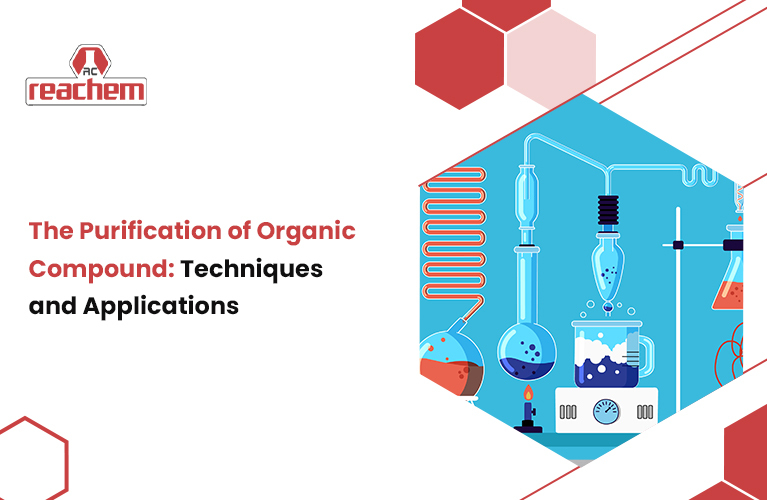wordpress-seo domain was triggered too early. This is usually an indicator for some code in the plugin or theme running too early. Translations should be loaded at the init action or later. Please see Debugging in WordPress for more information. (This message was added in version 6.7.0.) in /var/www/reachemchemicals.com/blog/wp-includes/functions.php on line 6131
Purification is essential in organic chemistry. It ensures compounds are free from impurities, making them suitable for various applications. Purification involves removing contaminants to achieve the desired compound quality. There are several techniques, each suited to different types of impurities and compounds. This blog explores the methods and their applications, guiding you through the process of purifying organic compounds. By understanding these methods, you’ll appreciate their role in producing pure, usable substances. Dive into the fascinating world of organic compound purification with this guide.
Purifying organic compounds is crucial for accurate experimental results. Impurities can alter reactions, leading to false data. Pure compounds ensure consistent and reliable outcomes in research and industry. Additionally, high-purity substances are essential for pharmaceuticals, ensuring safety and effectiveness. The process enhances product quality and value, making purification a vital step in chemical synthesis.
Several techniques are used to purify organic compounds. Each has unique applications and benefits. A few of them are:
Distillation separates components based on boiling points. Types of distillation are:
Simple distillation is used when the boiling points of components differ significantly. It involves heating the mixture until one component vaporises, then condensing the vapour back into a liquid.
Example: Purifying water from saltwater
Fractional distillation separates liquids with closer boiling points. It uses a fractionating column, enhancing separation efficiency.
Example: Refining crude oil into gasoline and other products
Crystallisation purifies solid compounds. Types of crystallisation are:
Recrystallisation involves dissolving the impure solid in a hot solvent and then slowly cooling it to form pure crystals. Impurities remain in the solution.
Example: Purifying benzoic acid
Fractional crystallisation separates compounds with different solubilities. It involves repeated dissolving and crystallisation steps.
Example: Separating sugar and salt from a mixture
Chromatography separates compounds based on how they move through a medium. Types of chromatography are:
TLC involves spotting the sample on a plate and developing it in a solvent. Compounds separate based on their affinity to the adsorbent.
Example: Checking the purity of synthesised compounds
Column chromatography involves packing a column with an adsorbent. The mixture passes through, separating based on compound interactions.
Example: Purifying natural products like plant extracts
GC separates volatile compounds. The sample vaporises and passes through a column with a carrier gas, separating based on boiling points.
Example: Analysing essential oils
Sublimation purifies compounds that transition from solid to gas without passing through a liquid state. It involves heating the solid until it sublimates, then condensing the vapour back to the solid.
Example: Purifying iodine or camphor
Extraction separates compounds based on solubility differences in two immiscible liquids. Types of extraction are:
Liquid-liquid extraction involves shaking the mixture with two immiscible liquids. Compounds are distributed based on their solubility.
Example: Separating caffeine from tea
Solid-liquid extraction dissolves compounds from a solid into a liquid.
Example: Extracting active ingredients from medicinal plants
Filtration separates solids from liquids. It involves passing the mixture through a filter, trapping solids, and allowing liquids to pass. Types of filtration are:
Gravity filtration uses gravity to separate solids from liquids. It’s ideal for removing large particles.
Example: Removing sand from water
Vacuum filtration utilises a vacuum to accelerate the process. It’s useful for separating fine particles.
Example: Collecting precipitated solids from a reaction
Each technique plays a crucial role in achieving pure compounds, which is essential for reliable research and industry results.
Purified organic compounds have various applications, which are as follows:
Pharmaceuticals require high-purity compounds to ensure safety and effectiveness. Impurities can cause side effects or reduce drug efficacy.
Example: Pure aspirin for pain relief
Purified compounds are essential for accurate chemical reactions. Impurities can interfere, leading to incorrect results.
Example: Synthesising new materials or chemicals
Purity is crucial in the food and beverage industry. Impurities can affect flavour, safety, and quality.
Example: Pure vanilla extract for baking
Purified compounds are used as standards in environmental testing. They ensure accurate detection and measurement of pollutants.
Example: Analysing water quality
These applications highlight the critical role of purified organic compounds in ensuring quality, safety, and precision across various fields.
Purifying organic compounds is a fundamental step in chemistry. It ensures compounds are free from impurities, enhancing their quality and suitability for various applications. Techniques like distillation, crystallisation, chromatography, sublimation, extraction, and filtration each play a vital role. Understanding and applying these methods is crucial for achieving pure, reliable compounds in research, industry, and everyday products. The importance of purification in organic chemistry cannot be overstated, making it a critical skill for chemists and researchers alike.